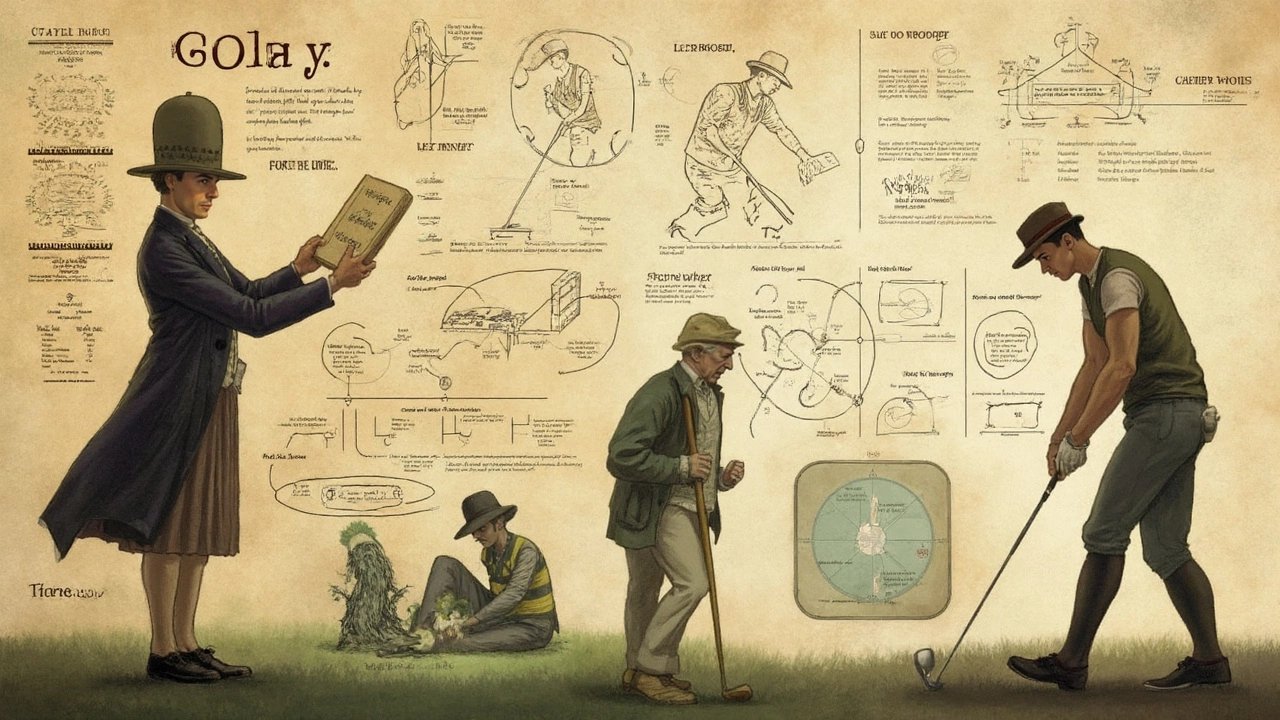Why is it Called a Bogey? The Meaning Behind Golf's Most Annoying Score

Ever wondered why golfers call one stroke over par a 'bogey'? It's one of those terms that sounds a bit quirky if you're not knee-deep in the golfing world. And there's a curious story behind it, wrapped up in Scottish culture and golfing evolution.
The term 'bogey' finds its roots in an old English word for a mischievous little spirit or phantom. Imagine that – the golfing world decided to name a score after a pesky spirit that just won’t leave you alone.
Back in the late 19th century, a 'Bogey Man' was a figure golfers tried to beat, like an early form of par. So, when a player's score exceeded that of the Bogey Man, they called it – you guessed it – a bogey.
- The Surprising Origin of the Word
- From Scotland to Golf Courses Worldwide
- Bogeys in the Modern Game
- Why It Matters: Strategy and Scoring
- Tips for Avoiding Bogeys
- Fun Facts and Trivia
The Surprising Origin of the Word
So, let's dig into why on earth a score in golf is called a bogey. If you've ever been frustrated after a shot went awry, you're in good company. The term actually traces back to late 19th-century Scotland, where the game itself really took shape.
The word 'bogey' was borrowed from British folklore, where a 'Bogey Man' or ghost-like figure was used in a popular song called 'The Bogey Man' that played across music halls. Golfers back in the day started using the term to describe a 'standard' score or the one set by players as the score to beat. This was a significant step before the common use of 'par' in the UK golf scene.
Golfers used this term as a challenge, originally viewing it as a term of achievement. By the early 20th century, as more structured rules and scoring systems became common, the term evolved. It shifted from being a target score to representing a score one stroke over that target – hence the origins of what we fuss about on the course today.
This wasn't just random golf course talk; it reflected a broader effort to formalize golf across various courses. So, next time you get a bogey, remember its roots are dug deep into the fun and folklore of golf history. Embracing its history might just ease a bit of the frustration!
From Scotland to Golf Courses Worldwide
The journey of the term bogey from its Scottish origins to golf courses across the globe is a fascinating tale of tradition and transformation. It all started in the late 19th century when golf in the UK, especially Scotland, began taking a modern form. The Scots, as the original patrons of golf, shaped many rules and terminologies that we use today.
The word 'bogey' appeared as part of regular play at clubs like the Great Yarmouth Golf Club in England. Here, players initially used the term to describe a score they aimed for, which was a couple of strokes under their usual capacity. Back then, a fictional character, 'The Bogey Man,' symbolized the course par—someone every player was eager to outdo.
As golf spread beyond the British Isles, countries embraced its weird and wonderful vocabulary, bogey included. The shift to a score that was one over par evolved with the Americanization of the game around the same time. This globalization of golf meant that terms like bogey settled into the lingo at clubs both in Europe and the budding courses in the United States.
Nowadays, whether you're teeing off in a local course in Japan or the famous greens of Florida, players everywhere know what a bogey means—thanks to this quirky piece of history born in Scotland. The spread of golf terminology like bogey underlines how the sport connects folks no matter where they tee off.
But still, every time you hear someone muttering about scoring a bogey, you're actually hearing an echo of golf's rich history and its ability to weave cultures together on courses around the world.
Bogeys in the Modern Game
Treating yourself to a golf day? Then you know bogeys are practically a rite of passage. In today's game, a bogey isn't just a minor setback; it plays a key part in strategy and keeping score. Even the pros have their share of bogeys, showing that it's not just a newbie's issue.
Modern golfers might crush it on the course but avoiding bogeys still remains a challenge, irrespective of your skill level. The difference is how players handle them. Some golfers play offensively, trying to recover quickly, while others go on the defensive, aiming for consistency over heroics.
To put numbers into perspective, an average professional male golfer might aim for a scoring average of par or better over a season. However, they actually make bogey on around 18% of their holes. For amateur golfers, those stats can jump significantly higher.
| Player Level | Bogey Frequency |
|---|---|
| Professional | 18% |
| Amateur | 30% - 50% |
In big tournaments, bogeys can really shake things up. A single bogey could mean the thin line between victory and being just another competitor. But remember, even legend Jack Nicklaus said, “Sometimes the most important shot in golf is the next one.” It's a reminder to shake off that bogey and focus on the overall game.
Next time you spot your ball rolling toward a sand trap or teetering on the edge of a bogey, take a deep breath. Remember that golf is as much about mental endurance as physical skill. Keep a cool head, plan your next step, and most importantly, have fun!

Why It Matters: Strategy and Scoring
When it comes to golf, understanding why a bogey matters is all about strategy and keeping that scorecard looking decent. In simple terms, a bogey means you're one stroke over par. It might not seem that bad, but in the world of golf where finesse and precision rule, every stroke counts big time.
Think about it. Every bogey bumps up your score and makes it harder to hit your target. And when you're out on the course trying to maintain a competitive edge, shaving off those extra strokes becomes your mission. It’s here that strategy comes into play.
Aiming to avoid bogeys requires smart thinking. You have to assess the course layout, weather conditions, and even choose the right clubs. Forget just whacking the ball; knowing when to play it safe or take a risky shot can make or break your game.
Got a long par-5 coming up? Sometimes playing for a bogey isn’t a bad plan if it increases your chances for a solid par on a tougher hole to follow. It’s all about managing the course, not letting it manage you.
In terms of scoring, bogeys can also tell you where your game's at. Tracking bogeys over several rounds can help spot weaknesses or patterns in play. Looking for improvement? Maybe you're always bogeying the tricky water hazard holes. Knowing this, you can practice those specific shots more intensely.
The takeaway? While a bogey might seem like a minor slip, it’s actually a key factor in shaping your overall game strategy and performance.
Tips for Avoiding Bogeys
Alright, let's get down to business. Nobody likes a bogey, but don't worry. There are some straightforward ways to keep those pesky additional strokes at bay. First off, always take a moment to get the lay of the land before you swing. What's the terrain like? Any sneaky hills or sand traps? A little scouting goes a long way.
Next on the list: club selection. It sounds basic, but picking the right club can seriously slash your risk of hitting a bogey. If you're questioning between two clubs, often the more forgiving one, even if it's a tad less powerful, will serve you better. Accuracy here is king.
Practicing your short game is another game-changer. Most errors that lead to bogeys happen around the green. Make sure you're as comfortable with a wedge or a putter as you are with your driver. Spend time chipping and putting, and you’ll find yourself dropping fewer shots.
- Plan your shots: Visualize your shot before hitting. This includes considering the wind direction, obstacles, and landing spot.
- Stay calm under pressure: Golf is a mental game. Keep your cool even after a bad shot. The worst thing you can do is let one bad hole snowball into a series of bogeys.
- Know when to play it safe: Going for that ambitious shot might seem tempting, but playing it safe can often keep your score down.
Remember, even pros land a bogey every now and then. It's about minimizing their occurrence. Play smart, stay cool, and you'll see those bogey numbers drop.
Fun Facts and Trivia
Diving into the history of golf and its terminology uncovers some pretty interesting tidbits. Did you know that the word bogey started from the British Isles? It originally described an imaginary opponent that players measured themselves against.
One quirky fact is that when the term gained popularity in the early 1900s, it wasn't exactly standardized. Different courses had different 'bogey' standards, depending largely on what the local pros decided was a manageable score. So, a bogey wasn't always just one stroke over the par we know today!
Here's a curious bit—there was a time when golfers could only record their scores for a national competition if they played with a 'Bogey System.' Yep, the network of golf clubs back then required you to measure your game against this ghostly golfer.
Ever heard of the 'Colonel Bogey'? In a 1914 song that became widely popular in Britain, Colonel Bogey was a fictional character who whistled his commands instead of using words. It added to the lore and made 'bogey' an even cooler part of golf culture.
- The longest recorded bogey shot is still a hot topic among golf historians—shockingly, getting a bogey has been a part of games that lasted up to 72 holes!
- At one point, the Webster's New International Dictionary defined 'bogey' simply as 'a score of one stroke over par,' which shows how entrenched it's become in everyday language.

